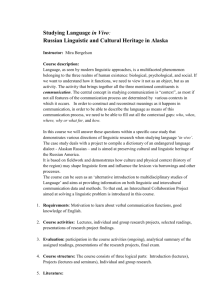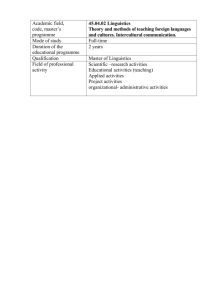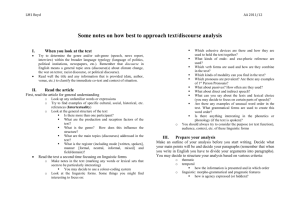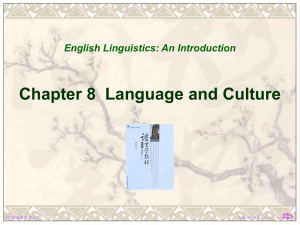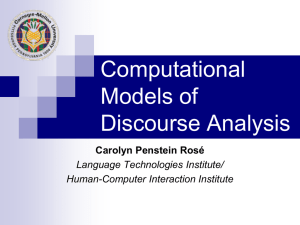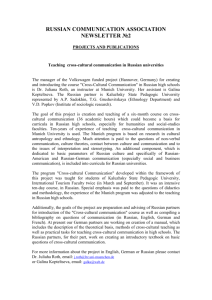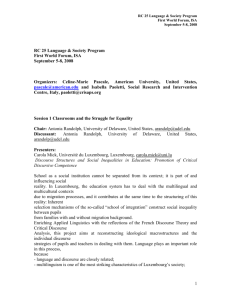Syllabus of the course Studying Language in Vivo: Cross
advertisement
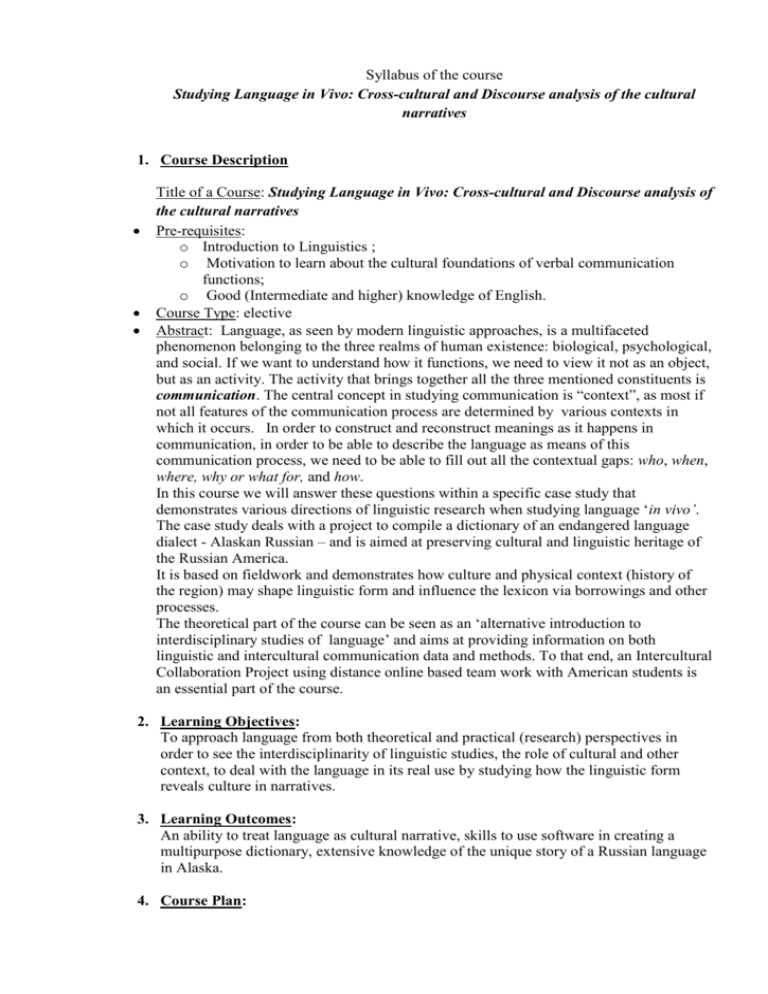
Syllabus of the course Studying Language in Vivo: Cross-cultural and Discourse analysis of the cultural narratives 1. Course Description Title of a Course: Studying Language in Vivo: Cross-cultural and Discourse analysis of the cultural narratives Pre-requisites: o Introduction to Linguistics ; o Motivation to learn about the cultural foundations of verbal communication functions; o Good (Intermediate and higher) knowledge of English. Course Type: elective Abstract: Language, as seen by modern linguistic approaches, is a multifaceted phenomenon belonging to the three realms of human existence: biological, psychological, and social. If we want to understand how it functions, we need to view it not as an object, but as an activity. The activity that brings together all the three mentioned constituents is communication. The central concept in studying communication is “context”, as most if not all features of the communication process are determined by various contexts in which it occurs. In order to construct and reconstruct meanings as it happens in communication, in order to be able to describe the language as means of this communication process, we need to be able to fill out all the contextual gaps: who, when, where, why or what for, and how. In this course we will answer these questions within a specific case study that demonstrates various directions of linguistic research when studying language ‘in vivo’. The case study deals with a project to compile a dictionary of an endangered language dialect - Alaskan Russian – and is aimed at preserving cultural and linguistic heritage of the Russian America. It is based on fieldwork and demonstrates how culture and physical context (history of the region) may shape linguistic form and influence the lexicon via borrowings and other processes. The theoretical part of the course can be seen as an ‘alternative introduction to interdisciplinary studies of language’ and aims at providing information on both linguistic and intercultural communication data and methods. To that end, an Intercultural Collaboration Project using distance online based team work with American students is an essential part of the course. 2. Learning Objectives: To approach language from both theoretical and practical (research) perspectives in order to see the interdisciplinarity of linguistic studies, the role of cultural and other context, to deal with the language in its real use by studying how the linguistic form reveals culture in narratives. 3. Learning Outcomes: An ability to treat language as cultural narrative, skills to use software in creating a multipurpose dictionary, extensive knowledge of the unique story of a Russian language in Alaska. 4. Course Plan: The course consists of three logical parts: Introduction (lectures), Projects (including lectures and seminars), Individual and group research. 1. Lecture topics: January 21 – February 4: Introduction to the Course February 18 – April1: Cultural narratives: Alaskan Russian case April 1 – June 3: Cross-cultural and Discourse Analysis of Narratives Intercultural Collaboration Project Narratives Reflect Culture January 28 – April 29 – including assignments Research project Ninilchik Russian Dictionary May 13 – June 10 5. Reading List: Required: 1. Scollon, R. and Scollon, S. B. K. (2005). Intercultural communication : a discourse approach. Malden, Mass., Blackwell Publishers. (selected chapters available electronically) 1. What is a Discourse Approach 2. How, When, and Where to Do Things with Language 3. Interpersonal Politeness and Power 4. Conversational Inference: Interpretation in Spoken Discourse 5. Topic and Face: Inductive and Deductive Patterns in Discourse 6. Ideologies of Discourse 7. What is Culture? Intercultural Communication and Stereotyping. 8. Using a Discourse Approach to Intercultural Communication 2. Julio C. Gimenez. Narrative Analysis in Linguistic Research. Research Methods in Linguistics. Lia Litosseliti(ed.). Bloomsbury Publishing, 2010. P. 198-215. see http://www.bloomsbury.com/uk/research-methods-in-linguistics-9780826489937/ 3. C. K. Riessman. Narrative Analysis. M.S. Lewis-Beck, A. Bryman and T. Futing Liao, eds (2003), The Sage Encyclopedia of Social Science Research Methods, Vol 3. http://eprints.hud.ac.uk/4920/2/Chapter_1_-_Catherine_Kohler_Riessman.pdf 4. Bergelson, Mira and Kibrik, Andrej. The Ninilchik variety of Russian: Linguistic heritage of Alaska. Slavica Helsingiensia 40: Instrumentarium of Linguistics. Sociolinguistic Approaches to Non-Standard Russian, Helsinki 2010, p. 299-313 Optional: 1. Agar, Michael. (1996). Language Shock: Understanding the Culture of Conversation. Harper Paperbacks. 288 p. (selected chapters available from the instructor) 2. Беликов В.И., Крысин Л.П. (2001). Социолингвистика. Учебник для вузов. Москва: Рос. гос. гуманит. ун-тю 2001. 439 с. 3. Перехвальская Е.В. Русские пиджины. СПб.: Алетейя, 2008. 6. Grading System: 7. Participation in the course activities -- 15% Includes assigned readings and taking part in the video conferences Research projects – 60 % Narratives Reflect Culture – 30 % Ninilchik Russian Dictionary – 30 % Final exam – 25 % - Home essay on the topic from the assigned readings - Presentation of the results from the Ninilchik Russian Dictionary project 8. Guidelines for Knowledge Assessment: 9. Methods of Instruction: Lectures, individual and group research projects, selected readings, presentations of research project findings 10. Special Equipment and Software Support (if required): Multimedia Projector, Internet Access, LexiquePro freeware tool
